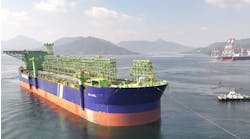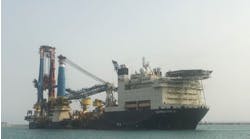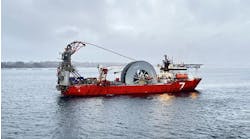Gas hydrates are not a new phenomenon for the off shore oil industry, but they are one the pro ducers are increasingly having to learn to live with. The move into deeper and colder waters, and the transport of unprocessed wellstreams over longer distances, has enhanced the need to take precautions against hydrate formation. But there may be a flip side to the traditional perception of hydrates as a problem, and interesting research is now taking place into how the properties of hydrates can be turned to advantage.
A considerable body of knowledge about hydrates has been built up over the last two decades. One of the leading centers of expertise is Trondheim, where both the SINTEF Petroleum Research and NTNU - the Norwegian University of Science and Technology - have a long involvement in investigating the phenomenon.
"We've tended to concentrate on problems, and especially plugs," says Roar Larsen, a senior research scientist specializing in hydrates at SINTEF Petroleum Research. Formerly known as IKU Petroleum Research, SINTEF Petroleum Research is probably best known for its role in the development of the OLGA multiphase pipeline design tool. Less well known is that in 1994/95 SINTEF personnel were allowed to carry out a number of experiments on a service line on Statoil's Tommeliten Gamma subsea development. A mass of useful data was collected, some of which has yet to be fully analyzed.
"One of the most important things we learned was that hydrate plugs are not imporous, as ice plugs formed from water are," says Larsen. "People at Statoil, for example, have reported seeing plugs with well over 50% porosity."
This means that the water content of the fluid stream need not be high to enable plugs to form. As gas seeps through the plug, it undergoes expansion cooling, which leads to further growth of the plug. In other words, the plug can grow even when the flow has already been stopped. Cases have been known of a single plug several km long.
One of the focuses of SINTEF's work has been to develop ways of removing plugs. A common approach is to lower the pressure to below the threshold for hydrate formation. This can be done by flaring off gas at the destination platform. However, as the pressure upstream of the plug is likely to remain high, it may also be necessary to depressurize on this side of the plug too, which can be a time-consuming and costly operation.
An alternative method is to heat the plug until it melts. However, there are dangers in this approach, Larsen says. As the heat is normally applied from outside the pipeline, the plug is likely to come free from the walls while the bulk of it is still unmelted. If the pressure upstream is high, it can then act as a projectile, traveling along the pipeline at speed until it meets a bend or obstacle such as valving and causing damage on impact or even rupturing the pipe wall.
Not knowing the exact location of the plug can also cause problems. As the hydrate melts, a lot of gas is released. "It's not widely realized that one cu meter of hydrate can contain up to 180 cu meters of gas," Larsen says. If the heat is applied to the middle of the plug while the ends remain frozen, sufficient pressure can be created by the gas in vapor to rupture the pipe. This happened on a Statoil platform in the mid-1980s. Fortunately, the personnel attempting to remove the plug had gone to lunch when the pipe exploded, so no one was hurt.
Hydrates as resource
Enormous amounts of gas are thought to be exist in hydrates trapped in sediments on the seabed and in permafrost. In fact, the carbon content of this gas resource could amount to more than all the known reserves of gas, oil, and coal. However, there are important environmental issues to be considered in using the gas locked up in hydrates, Larsen says. It is methane, which on a molecule for molecule basis, is about 20 times worse than carbon dioxide as a greenhouse gas.
Methane from hydrates can be released into the environment by natural events such as seabed earthquakes and landslides. Hydrates are thought to have played a role in the Storegga slide which occurred in the North Sea 7,000-8,000 years ago. Thought to have been triggered by earthquakes, some 5,000 cu km of mass was sent sliding 800 km across the North Sea, causing tsunami waves to wash over the shores of both Norway and Scotland. Hydrates on the seabed were thought to have melted in the initial sliding process, acting as ball bearings, and making the slide much larger than it would otherwise have been.
The cataclysmic Storegga slide is of more than just academic or historical interest. The giant Ormen Lange gas field is situated just below the first slope traversed by the slide, and the field licensees have asked SINTEF to consider whether the heat generated by wells and subsea pipelines on the field would be sufficient to melt seabed hydrates and affect the stability of the seabed in the surrounding area.
Meanwhile SINTEF's attention has been attracted by the experimental finding that as hydrates form, they first pass through a sticky phase, a property which helps in plug formation. Eventually, they take on a dry, powder-like form which flows readily, and even when stopped, does not agglomerate to form a plug. "We think we've found a way of side-stepping the sticky phase and reaching the powder-like phase, thus overcoming the problem of plug formation," says Larsen. "Others are trying to do the same using specially developed chemicals, but our method involves only mechanical manipulation of the flow."


